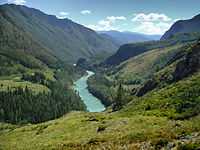Katun River
| Katun (Катунь) | |
| River | |
 The Katun River in Tungur village | |
| Name origin: "woman", Altay language | |
| Country | Russia |
|---|---|
| Regions | Altai Republic, Altai Krai |
| Part of | Ob River basin |
| Tributaries | |
| - left | Koksa River, Ursul River, Kamenka River (Katun) |
| - right | Koutcherla River, Argout River, Chuya River, Icha River |
| Source | Katun Glacier |
| - location | Belukha Mountain, Altai Republic |
| - elevation | 2,300 m (7,546 ft) |
| - coordinates | 49°44′40″N 86°39′41″E / 49.74444°N 86.66139°E |
| Mouth | Ob River |
| - location | Confluence with Biya River, near Biysk, Altai Krai |
| - elevation | 195 m (640 ft) |
| - coordinates | 52°25′54″N 85°01′26″E / 52.43167°N 85.02389°ECoordinates: 52°25′54″N 85°01′26″E / 52.43167°N 85.02389°E |
| Length | 688 km (428 mi) |
| Basin | 60,900 km2 (23,514 sq mi) |
| Discharge | for Srotski, 58 kilometres (36 mi) from the mouth |
| - average | 617 m3/s (21,789 cu ft/s) [1] |
| - max | 2,930 m3/s (103,472 cu ft/s) |
| - min | 16 m3/s (565 cu ft/s) |
The Katun River (Russian: Катунь) is a river in the Altai Republic and the Altai Krai of Russia. It forms the Ob River as it joins the Biya River some 19 kilometres (12 mi) southwest of Biysk. The Katun River is 688 kilometres (428 mi) long, and its drainage basin covers 60,900 square kilometres (23,500 sq mi). It originates in the Katun glaciers on the southern slope of Belukha Mountain. The river freezes up in the late November or early December and breaks up in the early or mid-April. The Katun River has a few tributaries: Argut River, Chuya River, Koksa River and Sema River. The river is navigable.

The upper reach of the Katun River flows down the distant and sparsely populated area, but a few kilometers downstream near the Kujus village, the coastal population density grows steadily and the area downstream of the Ust-Sema village is the most populated. There are numerous buildings, holiday camps and various guest houses in the pine forest near the village.
References
- ↑ "Katun River discharge at Srotski". Soviet Union Hydro-Station archive. UNESCO. 1936–1990. Retrieved 2010-11-12.